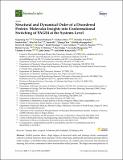| dc.contributor.author | Lin, Xingcheng | |
| dc.contributor.author | Onuchic, José N. | |
| dc.date.accessioned | 2020-05-18T19:52:37Z | |
| dc.date.available | 2020-05-18T19:52:37Z | |
| dc.date.issued | 2019-02 | |
| dc.date.submitted | 2019-01 | |
| dc.identifier.issn | 2218-273X | |
| dc.identifier.uri | https://hdl.handle.net/1721.1/125296 | |
| dc.description.abstract | Folded proteins show a high degree of structural order and undergo (fairly constrained) collective motions related to their functions. On the other hand, intrinsically disordered proteins (IDPs), while lacking a well-defined three-dimensional structure, do exhibit some structural and dynamical ordering, but are less constrained in their motions than folded proteins. The larger structural plasticity of IDPs emphasizes the importance of entropically driven motions. Many IDPs undergo function-related disorder-to-order transitions driven by their interaction with specific binding partners. As experimental techniques become more sensitive and become better integrated with computational simulations, we are beginning to see how the modest structural ordering and large amplitude collective motions of IDPs endow them with an ability to mediate multiple interactions with different partners in the cell. To illustrate these points, here, we use Prostate-associated gene 4 (PAGE4), an IDP implicated in prostate cancer (PCa) as an example. We first review our previous efforts using molecular dynamics simulations based on atomistic AWSEM to study the conformational dynamics of PAGE4 and how its motions change in its different physiologically relevant phosphorylated forms. Our simulations quantitatively reproduced experimental observations and revealed how structural and dynamical ordering are encoded in the sequence of PAGE4 and can be modulated by different extents of phosphorylation by the kinases HIPK1 and CLK2. This ordering is reflected in changing populations of certain secondary structural elements as well as in the regularity of its collective motions. These ordered features are directly correlated with the functional interactions of WT-PAGE4, HIPK1-PAGE4 and CLK2-PAGE4 with the AP-1 signaling axis. These interactions give rise to repeated transitions between (high HIPK1-PAGE4, low CLK2-PAGE4) and (low HIPK1-PAGE4, high CLK2-PAGE4) cell phenotypes, which possess differing sensitivities to the standard PCa therapies, such as androgen deprivation therapy (ADT). We argue that, although the structural plasticity of an IDP is important in promoting promiscuous interactions, the modulation of the structural ordering is important for sculpting its interactions so as to rewire with agility biomolecular interaction networks with significant functional consequences. Keywords: PAGE4; intrinsically disordered proteins; conformational plasticity; order–disorder transition; phosphorylation | en_US |
| dc.publisher | Multidisciplinary Digital Publishing Institute | en_US |
| dc.relation.isversionof | 10.3390/biom9020077 | en_US |
| dc.rights | Creative Commons Attribution 4.0 International license | en_US |
| dc.rights.uri | https://creativecommons.org/licenses/by/4.0/ | en_US |
| dc.source | Multidisciplinary Digital Publishing Institute | en_US |
| dc.title | Structural and dynamical order of a disordered protein: molecular insights into conformational switching of PAGE4 at the systems level | en_US |
| dc.type | Article | en_US |
| dc.identifier.citation | Lin, Xingcheng, et al., "Structural and dynamical order of a disordered protein: molecular insights into conformational switching of PAGE4 at the systems level." Biomolecules 9, 2 (Feb. 2019): no. 77 doi 10.3390/biom9020077 ©2019 Author(s) | en_US |
| dc.contributor.department | Massachusetts Institute of Technology. Department of Chemistry | en_US |
| dc.relation.journal | Biomolecules | en_US |
| dc.eprint.version | Final published version | en_US |
| dc.type.uri | http://purl.org/eprint/type/JournalArticle | en_US |
| eprint.status | http://purl.org/eprint/status/PeerReviewed | en_US |
| dc.date.updated | 2019-03-01T10:47:16Z | |
| dspace.orderedauthors | Lin, Xingcheng; Kulkarni, Prakash; Bocci, Federico; Schafer, Nicholas; Roy, Susmita; Tsai, Min-Yeh; He, Yanan; Chen, Yihong; Rajagopalan, Krithika; Mooney, Steven; Zeng, Yu; Weninger, Keith; Grishaev, Alex; Onuchic, José; Levine, Herbert; Wolynes, Peter; Salgia, Ravi; Rangarajan, Govindan; Uversky, Vladimir; Orban, John; Jolly, Mohit | en_US |
| dspace.embargo.terms | N | en_US |
| dspace.date.submission | 2019-04-04T13:35:51Z | |
| mit.journal.volume | 9 | en_US |
| mit.journal.issue | 2 | en_US |
| mit.license | PUBLISHER_CC | en_US |
| mit.metadata.status | Complete | |
